Following the death of Francis Xavier, S. J., on the 3rd of December 1551, in Shangchuan Dao,• (Port.: Sanchoão; or the Bay of the Portuguese), thirty-five Jesuits, twenty-two Franciscans, one Dominican and one Augustinian arrived in China. Their intention was to settle, but it was an intention which was ultimately to be thwarted. The reason for this failure was explained to the Jesuit priest, Francisco Perez, S. J., (°1514-†583), with due politeness in the midst of the etiquette surrounding the ambassadorial mission to Guangzhou led by Gil de Goes in 1564: they could not speak Chinese.
It was in order to counter this that Pompilius (later, Michele) Ruggieri, S. J., (°1543-†1607) arrived in Macao on the 20th of July 1579, later followed by Matteo Ricci [Li Madou],• S. J., (°1552-†1610) on the 7th of August 1582, where they set about applying themselves seriously to the study of the language of Confucius. There they were first taught by Filipe Mateus, chosen from the jurubaças (official interpreters) of the recently-founded port of the [Santo] Nome de Deus ([Holy] Name of God) — the catechumenate of St. Martin of Tours, in Macao, was only founded in 1580, near the present ruins of the old College of St. Paul, thanks to a donation made by an Italian merchant — as Macao was referred to by Francisco Perez, S. J., founder of the first residence of the Society of Jesus in Macao, in December 1565.
Michele Ruggieri made repeated trips to Guangzhou (a few days before the 3rd of April 1580, twice before the 3rd of April 1581, and in April-May 1582 with Alonso Sanchez) and Zhaoqing· (in the company of the Ouvidor (Teller) Matias Penela) and as such was a major forerunner of Matteo Ricci. During the latter visit, the two were received in mid-May 1582 by Wang Pan,• Prefeito (Prefect) or Governador (Governor) of the city, escorted by three hundred officers and soldiers. [...].
On the 27th of December 1582, in the company of Francesco Pasio, S. J., Ruggieri returned to Zhaoqing where he celebrated the first mass on the 10th of January 1583. He finally introduced Matteo Ricci eight months later, on the 10th of September 1583, the date on which he received authorisation to live in the city (the summer residence of the Viceroy of Liangguang• (Guangdong and Guangxi).
The two priests took to dressing like bonzes, shaving their heads and cutting their beards, not yet aware that Buddhism had already been discredited in China. Ricci was to correct this error eight years later in Shaozhou• (presently Shaoguan)• the city in which the Sixth Patriarch of chan • or zen Buddhism, Huineng,• had died in 713 at the age of seventy six. The sect, founded by the monk Indo-Bodhidarem, spread to Japan towards the end of the Ming dynasty where it has flourished until the present day. 1
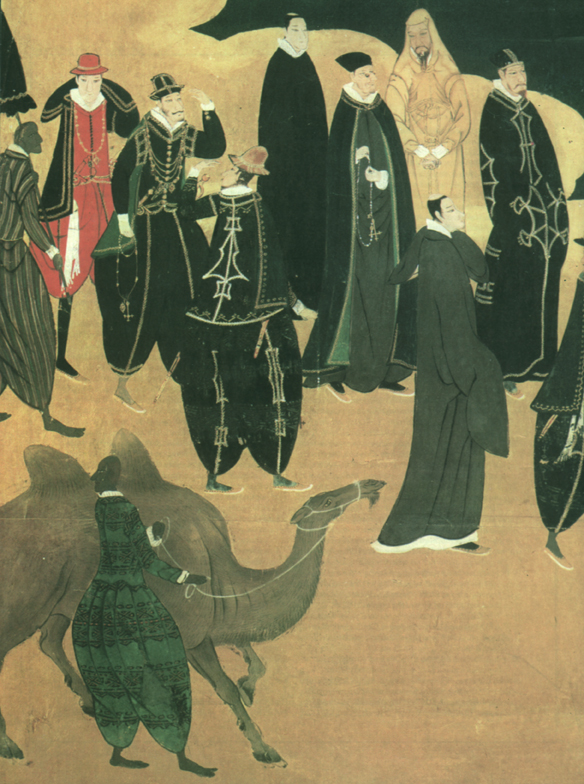 PREVIOUS PAGE:
A pair of six fold Japanese screens — detail.
KANO NAIZEN seal. Kano School. ca 1603-1610?.
Tempera on gold-leafed rice paper. 178.00 cm x 366.0 cm.
Museu Nacional de Arte Antiga (National Museum of Ancient Art), Lisbon — Permanent loan from the Ministério das Finanças (Ministry of Finance), 1954.
"Ashore, sailors and slaves resume their normal duties. One leads a camel — an animal unknown in Japan until the Portuguese arrived. Among the groups on the beach, watching the unloading one can distinguish, by the colour of their habits, Jesuits, Dominicans and Franciscans."
In: PINTO, Maria Helena Mendes, Biombos Namban / Namban Screens, Lisboa, Museu Nacional de Arte Antiga, 1986, p.65
PREVIOUS PAGE:
A pair of six fold Japanese screens — detail.
KANO NAIZEN seal. Kano School. ca 1603-1610?.
Tempera on gold-leafed rice paper. 178.00 cm x 366.0 cm.
Museu Nacional de Arte Antiga (National Museum of Ancient Art), Lisbon — Permanent loan from the Ministério das Finanças (Ministry of Finance), 1954.
"Ashore, sailors and slaves resume their normal duties. One leads a camel — an animal unknown in Japan until the Portuguese arrived. Among the groups on the beach, watching the unloading one can distinguish, by the colour of their habits, Jesuits, Dominicans and Franciscans."
In: PINTO, Maria Helena Mendes, Biombos Namban / Namban Screens, Lisboa, Museu Nacional de Arte Antiga, 1986, p.65
§ 1. THE FIRST WORKS IN CHINESE AND 'CULTURAL ACCOMMODATION'
The first book to be printed in Chinese in Macao by Michele Ruggieri was the Simple Explanations / Concerning the Ten Commandments / [of] The Holy Doctrine of the Lord of Heaven. In 1581, Ruggieri, while still in Macao, also drafted the first catechism in Chinese, based on a rough draft by the Spaniard Pedro Gomez, Superior of the Society of Jesus in this city. Before the end of November 1584, the book was revised with the help of a man of letters who [...] was at home [...], from Fujian. •A married man with a family, he had passed the Imperial exam and had come to live with the two Italian Fathers in May 1584. He was baptised by Fr. Francisco Cabral on the 21st of October 1584 and given the name of Paul, ** later becoming an apostle. There were soon thousands of copies of the catechism which even reached as far afield as Cochin-China.
In 1595, Ricci was working on another catechism [...] a far better one and better organised [...], which was published only in 1603 under the title Tianzhu shiyi• (True Meaning of the Lord of Heaven).
Whereas in 1584 Ricci required an interpreter (the Sino-Portuguese Filipe Mendes), who accompanied him to Zhaoqing, in 1585 he was already reading and writing regularly without assistance and, in 1595, he made his first attempts to translate the works of Marcus Tullius Cicero (°106-†43 BC) and Epitectus (AD °50-†138) into Chinese. According to Fr. Álvaro de Semedo, S. J., (°1586-†1658) however, even ten years after he had arrived in China, Ricci still required the help of a man of letters: Nature does not move in leaps and bounds [...].
With the help of members of the Chinese scholars (literati), in 1591 he translated the Chinese classic Shishu• (Four Books) into Latin with a commentary by Zhang Juzheng,• Grand Secretary and Imperial Tutor to Emperor Wanli• (r.1573-†1620) during the first ten years of his long reign.
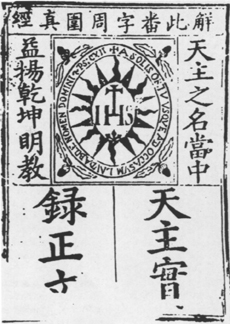 Frontespiece.
The first book printed in Macao by Fr. Michele Ruggieri, S. J., in 1585. Top (horizontally): Concerning the Ten Commandments [Spreading the Word of the Bible]
Middle left (vertically): The Light of Catholicism Shines Upon Heaven and Earth
Middle right (vertically): The Holy Name of God Is at the Centre of Heaven
Bottom left (vertically): Simple Explanations... [This is the Basic Text of...]
Bottom right (vertically): .... The Holy Doctrine of the Lord of Heaven [... True Catholicism]
Frontespiece.
The first book printed in Macao by Fr. Michele Ruggieri, S. J., in 1585. Top (horizontally): Concerning the Ten Commandments [Spreading the Word of the Bible]
Middle left (vertically): The Light of Catholicism Shines Upon Heaven and Earth
Middle right (vertically): The Holy Name of God Is at the Centre of Heaven
Bottom left (vertically): Simple Explanations... [This is the Basic Text of...]
Bottom right (vertically): .... The Holy Doctrine of the Lord of Heaven [... True Catholicism]
The God of the Catholics was given the name of "True [...] Lord of Heaven", by a catechumen, João Chen,• in July or August, 1583. 2 This was approved by the missionaries and has been used until the present day. The name derived from Devapati (Master of Gods), an Indra name, which the Daoists used. Before Buddhism was introduced into China, the Chinese word, which first appeared at the end of the twelveth Century AD, was understood to mean one of the eight ruling divinities [sic] (of Earth, War, of the feminine principle Yang,• the masculine Yin,• of the Moon and the Four Seasons) to whom the Emperor Shihuang• of the Qin• dynasty made sacrifices. It was only much later that Ricci realised it was probably of Buddhist or pagan origin, but it was already in use and he did not change it to avoid upsetting people.
During the years 1583-1584 the Zhaoqing Catholic community was composed of four people: Matteo Ricci, Michele Ruggieri, Br. Baltasar (or Gonçalo) and the Chinese interpreter Filipe Mendes, who dressed in European style.
The Zhaoqing Mission residence, built in European style, was completed in May 1585 with money Ruggieri had managed to acquire from Macao, and cost more than two hundred thousand taels, the equivalent of approximately six thousand Ducats. The church featured an artistic frontispiece with lettering designed by Wang Pan, * which has been preserved to this day. The original statue of Our Lady [Shengmu niangniang• (Goddess Holy Mother), Tianfei• (Heavenly Lady) or Tianhou• (Heavenly Empress)] was replaced by that of the Holy Saviour, in order to avoid confusion. A wooden cross was raised above the house.
In the reception room there were clocks, which the Chinese called 'automatic bells', brass globes many terrestrial and some 'celestial' —, a number of sundials, Venetian prisms in glass (considered a priceless stone) Western oil paintings sent from Rome, the Philippines, Spain and Japan, and richly bound books decorated with gold leaf on architecture and cosmography. There was also a copy of the Polyglot Bible of Anvers (eight volumes) with a gold cover, solar quadrants, and two clocks for the Wanli Emperor, who in early 1608 was eager to see a second and more perfect "World map" by Ricci — the first being compleated 1n 1602. Ricci (†1610) was never to see the Emperor, however.
Between 10th September 1583 and 1st of August 1589, the Jesuit priests recorded only eighty baptisms, and only two of these were performed on distinguished individuals. The Zhaoqing Mission residence was filled with visiting mandarins who came to the city to visit the Viceroy [sic] but the children and their pranks damaged the mirrors and windows and finally Ricci, losing patience, returned to Macao dejected. It was only through the efforts of Dom Melchior Carneiro, S. J., (°1526-†1573) Apostolic Vicar and First Bishop of Macao (1568-1581), that he decided to return to China.
Ricci adopted the method of"[...] without abandoning the humble people, concentrating all effort and energy on societys leaders, who in China were the mandarins or literati. This method of 'Cultural Accommodation' was both as old and as new as St. Paul's maxims: "Do all things for all people, in order to benefit all for Christ"3 and "To enter with what is theirs, to leave with what is ours."
Francis Xavier had used this method in Japan, and Alessandro Valignano, Henrique Henriques, Roberto de Nobili, João de Brito and others employed it in the East. Essentially the concept was to expand and adopt all aspects of the truth that already existed within the cultural context one found oneself in and not simply to impose the Western model. The idea was to adapt to one's surroundings without betraying Catholic faith and morality, thus contrasting with the traditional ethnocentric expansion of history's great military conquerors. 4
2. THE MOVE TO SHAOZHOU AND PROGRESS IN 'CULTURAL ACCOMMODATION'
(29th of August, 1589 - 18th of April, 1591)
The Viceroy of Guangzhou [sic], Wu wenhua, *** moved to Nanjing and was replaced in 1587 by Wu Shan, * Viceroy of Guangdong and Guangxi, who died a few months later of old age. He was succeeded by Li Zhizao,• "[...] a cruel, ambitious man and a friend of money [...]," who quickly had the palace where his predecessor had died completely restored.
Lending an ear to the many intrigues against the European missionaries, he expelled them from the city and confiscated their residence on the 1 st August 1589, allowing them, however, to move to Shaozhou in the North of the province.
The voyage began on the 15th of August of the same year and ran into difficulties. António de Almeida, S. J., [...] young, highly virtuous and full of holy fervour [...], who had already accompanied Ruggieri to Zhejiang and to Gansu, was very ill on arrival and returned to Macao. He stayed in the Portuguese territory until nearly the end of 1589 when he returned to China, but fell ill again in Shaozhou, on the 11th October 1591, and died, edified, eight days later, his bones probably being moved to Macao in December 1593. 5
The missionaries initially stayed at the Kong Hao* monastery, home to one thousand monks. Ricci spent a night there closely observing all that went on about him and then the following day proceeded to the city proper, a much larger conurbation than that of Zhaoqing.
With the approval of Valignano, they dropped the title of bonze and decided to let their beards and hair grow. They also took the decision to adopt the attire worn by literati, to wear silk when visited by mandarins and to build their residence and church, which was completed between October and December 1590, in the Chinese style.
Their consolation was to see the first Chinese Jesuit priests from Macao join the Society on the 1st of January 1591. These two, Sebastião Fernandes, who took his vows in Portuguese (the document still exists) before the Italian Jesuit, Niccolò Longobardo, and Francisco Martins, who was killed in Guangzhou performing God's mission on the 20th of January 1606, were to be of much use to the Jesuits later on. Another missionary, Francesco de Petris, S. J., who arrived around the 20th of December 1591, but died on the 5th November 1593. He was replaced by Lazzaro Cattaneo, S. J..
Between the months of January and June, Ricci spent his time translating Euclid's (ca 300 BC) Elements of Geometry into Chinese with the help of (Paul) Xu Quangqi. The work was finally completed between August and October, 1606.
In December 1591, Ricci began the Latin translation of the Chinese classic Sishu (Four Books), which he completed on the 15th of November of the following year. Also at this time, between November and December 1591, Ricci, for the first time, gave the Ejercicios Spirituales (Spiritual Exercises) of St. Ignatius of Loyola in Chinese.
As they advanced towards Beijing, Ricci and his companions, with the addition in Nanchang of another Jesuit, João Soeiro, who took solemn vows on the 1st of January 1596, could be seen to be making progress in their command of the language and their adaptation to the local culture.
On the 4th of September, 1592, Ricci rose to the distinguished position of General Superior of the Order. During March and April 1600, he was in Nanjing with Xu Guangxi, born in Zi-Ka-Wei, * a suburb of Shanghai,"• one of the literati who was to help him most in the future.
Noting that the literati of Guangdong tended to deny the immortality of the soul in contrast to those in the centre of the country, he concluded that the neo-Confucionist school had replaced the earlier Daoist concept of Heaven with the theory of an impersonal and purely material universe (Li• and Chi).• In Nanjing, in debates with the Buddhist, San Huai• (Huang Hong'en,• °1545-†1608) and in Beijing with Huang Hui• (†1589), jinshi• (Tutor) to the Crown Prince Zhu Chanluo• (°1582-†1620), Ricci became aware that the arguments put forward by the Chinese were not only based on absolute definitions but on a fluid description of reality.
Although the conversion of souls to Catholicism had not been spectacular, only twenty-two baptisms were recorded up to the 15th of December 1592, in Shaozhou, the tree that had been planted, had put down solid roots and was to bear lasting fruit. At the time of Ricci's death in 1610 in the interior of China, there were sixteen Jesuits (six European Fathers and eight Chinese Brothers) and twenty five thousand Catholics, including several famous mandarins.
Through their knowledge of geography, astronomy and mathematics, as well as the arts and politics, there can be no doubt that Ricci and his pleiad of Jesuit successors contributed enormously to the development of China.
3. JOÃO RODRIGUES, S. J.: TÇUZZU (THE INTERPRETER) (°1561-†1633)
In his fine biography, 6 Michael Cooper, describes João Rodrigues as the greatest missionary to have worked in Japan. Born around 1561 in Sernancelhe, a town located on the banks of the Távora, some twenty five miles from the city of Lamego, in the Beira Alta province of Portugal (stories suggest he may have been a descendant of Dona Flâmula Rodrigues, the tenth century Lady of the town castle), he left his native land, which he was never to see again, but which, even after more than fifty years in Asia he was still to refer to with affection and nostalgia, when he was still only twelve or thirteen years of age.
He arrived in Japan, where he was to remain, bar a brief visit to Macao, for the next thirty-three consecutive years, on the 4th of July 1577, at Nagasaki, via some of the islands of the Ryukyu [Port.: Léquias; or, Liuqiu, Liu-ch'iu, Luchu, Loochoo] archipelago, probably on board a ship owned by Domingos Monteiro.
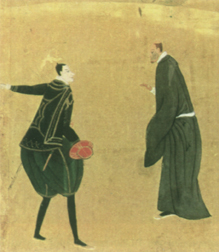
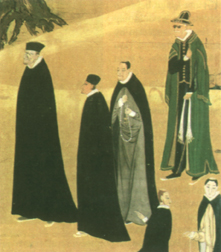
A pair of six fold Japanese screens — detail.
KANO NAIZEN seal. Kano School. ca 1603-1610?.
Tempera on gold-leafed rice paper. 178.00 cm x 366.0 cm.
Museu Nacional de Arte Antiga (National Museum of Ancient Art), Lisbon — Permanent loan from the Ministério das Finanças (Ministry of Finance), 1954.
"The Namban screen painters illustrated Nagasaki with some taller buildings crowned with a cross. Scenes of Catholicism (and the way of life of the Jesuit mission) can be seen through the wide doors and windows. When this screen was painted, priests of other orders apart from the Jesuits had been authorised by Papal Bull to be missionaries in Japan"
In: PINTO, Maria Helena Mendes, Biombos Namban / Namban Screens, Lisboa, Museu Nacional de Arte Antiga, 1986, p.69
At the time of his arrival, Japan was suffering the upheaval of unification. Oda Nobunaga (°1534-†1582), who controlled half of the sixty-six provinces, had begun a process which would only be finally completed by daimyo Tokugawa Ieyasu (°1542-†1616), a man Rodrigues would come into contact with in later years, at the battle of Sekigahara (lit.: moor of the barriers), on the 21st of October 1600.
Three years later, in 1580, at the age of nineteen, João Rodrigues began to study Japanese in Funai [presently Oita]. Together with a group of twelve young Japanese and eight Portuguese, he became a Jesuit novice in Usuki, in the feudal state of Bungo, and he attended some of the classes taught by Valignano. In the Autumn of 15 81, he began studying Greek and Latin humanities and two years later he went on to study philosophy, which he interrupted for diplomatic duties. He also studied theology in Nagasaki, again interrupted because of diplomatic duties at Court.
Due to his success in learning the local language, Rodrigues was chosen by Valignano to be his 'tsuji' (chief interpreter) — thus his Japanese nickname, or 'Tçuzzu'— for an ambassadorial mission he had been charged with undertaking on behalf of the Viceroy of the Portuguese State of India. This mission was to Toyotomi Hideyoshi (°1536-†1598), a powerful General, who was so delighted with Rodrigues that he was chosen to fill the position of official interpreter, an office that he would also fulfill under Ieyasu.
At the age of thirty-five, between April and July 1596, João Rodrigues and another five Jesuits were ordained as priests in Macao by Bp. Dom Pedro Martins, S. J., Bp. of Funay and Administrator of the Diocese of Macao (1585-1594). On the 21st of July the latter returned to Nagasaki with the newly ordained priests in the carrack belonging to Rui Mendes de Figueiredo and the interpreter accompanied the Bishop in an audience with Hideyoshi, in his palace in Fushimi, three or four miles from Meaco (lit.: the capital) [presently Kyoto], on the 16th of November of that same year.
The position and esteem with which Rodrigues was held can be seen by events in 1597. On the 20th of March of that year, Hideyoshi, on behalf of the bugyo (Governor) of Nagasaki, ruled that all priests be expelled from Nagasaki. The only exceptions made were for Rodrigues and those priests considered essential for the continuing of trade with Macao. Neither was any restriction placed on Rodrigues place of residence, choosing as he did to remain close to the twenty-six martyrs of the 5th of February 1597, so as to console them. Also, in April 1598, the kwampaku (Regent-honorific Court title held from 1589-1592) Hideyoshi was particularly generous to Rodrigues in Meaco, giving him a crucifix and ivory cross containing relics, as well as vestments that had been seized from the cargo on board the ship San Felipe, shipwrecked in Hirado island on the 20th of October.
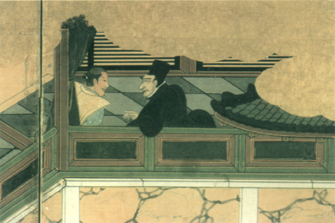
'Tçuzzu' (the 'interpreter') visited Hideyoshi for the last time on his death bed, and spoke to him of eternal life and baptism, and in return received silk kimonos. The great tairo (Minister-honorific Court title held from 1592-1598) died on the 16th
September 1598, apparently after he had composed these nostalgic lines of verse:
"Oh! I fall like dew,
I break like frost!
Even the Castle of Osaka is a dream within another dream!"
In 1598, at the age of thirty-seven he was one of the four Advisors to António Lopes, S. J., Rector of Nagasaki, a Superior who had lived for more than twenty-one years in Japan.
Rodrigues was appointed Deputy of the Japan Mission in that same year and was solemnly sworn into his office (his written vows are still preserved in Rome) in Nagasaki on the 10th of June 1601.
Although João Rodrigues diplomatic functions were extremely useful to the mission and in developing trade with Macao, the older members, of the Society of Jesus (particularly Organtino) did not approve.
It was his appointment to another position, however, that of commercial agent in Nagasaki for daimyo Tokugawa Ieyasu, that brought him the greatest displeasure and would ultimately lead him to leave Japan for Macao in 1610. A victim of envy and libel, he was criticised by Bp. Dom Luís Cerqueira and suffered the enemity of Murayama Toan, who had actually been recommended to Ieyasu by João Rodrigues, and Sahyoe Hasegawa, who, in the opinion of the Visitor Francisco Vieira (1615-1619),"[...] unjustly persecuted him and forced him to leave Japan [...]"7 at the age of forty-nine.
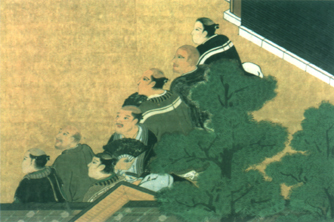
A pair of six fold Japanese screens — detail.
KANO NAIZEN seal. Kano School. ca 1603-1610?.
Tempera on gold-leafed rice paper. 178.00 cm x 366.0 cm.
Museu Nacional de Arte Antiga (National Museum of Ancient Art), Lisbon — Permanent loan from the Ministério das Finanças (Ministry of Finance), 1954.
"The priest come out to meet de procession announced by a gesticulating Portuguese, under the curious eyes of the Japanese who watch the scene attentively"
In: PINTO, Maria Helena Mendes, Biombos Namban / Namban Screens, Lisboa, Museu Nacional de Arte Antiga, 1986, p.44-45
Despite these important responsibilities, however, Rodrigues still found time and energy for his two-hundred and forty page masterpiece, the Arte Breve de Língoa Japoa (Art of the Language of Japan), which he began in 1604 and completed in 1608. It is here and in the summary that he wrote in Macao in 1620, Arte Breve de Língoa Japoa (Compendium of the Art of the Language of Japan), that he reveals his profound knowledge, still valid today, of this difficult language and its vast literature. Composed of three sections: 1. Noun and pronoun declensions and verb conjugations, 2. Rudiments of the eight parts of the language, and 3. Syntax and language structure, the literary work identifies Japanese as a non-inflected language without cases and verb conjugations. In the second section of the book, part of João Rodrigues' grammar is more original and deals with common linguistic mistakes made by foreigners and difficulties in translating Portuguese into Japanese. He states that in his opinion he believes the language spoken in the capital [i. e., Meaco] (of which Gaspar Vilela, S. J., was a specialist) to be the highest form of Japanese and the model most worthy of imitation both in the area of pronunciation and vocabulary. The phonetic system he developed using Latin and Portuguese letters for the pronunciation of Japanese was the forerunner of the current 'Hepburn system' of romaji and is still accepted by current Japanese philologists. The work even includes Chinese poetry translated into Japanese, the history of Buddhism, Daoism and Confucionism in China, and an avalanche of other useful information.
In 1615 Rodrigues appears as a preacher and Adviser to the Provincial of the Society of Jesus in the City of the [Holy] Name of God, and Assistant to the Visitor.
From June 1613 to July 1615, he travelled throughout China doing in depth research into the teachings of Chinese sects in order to refute them. He was, therefore, entering the arena of 'Cultural Accomodation' to which Matteo Ricci and his successors were dedicated. He speaks of the Nestorians and the Jews in China.
João Rodrigues may have visited the five principal residences of the Jesuits in China and in 1615 he was in Beijing.
Despite his criticism of the terminology used by Ricci and his companions, assisted by qualified scholars, Rodrigues did not manage to put his point of view across. The serious Chinese Rites Controversy, was after all a criticism of Jesuit terminology, and was only definitely settled in 1932 by Pio XI.
After his Arte Breve de Lingoa Japoa was published in Macao in 1620, Rodrigues, at the request of the Vice-Provincial Jerónimo Rodrigues (1614-1617) and the Provincial Francisco Pacheco (1621-†1626) in Japan, was asked to write the Historia da Igreja do Japão, na qual, se contam, como se deu principio a pregacao do Sagrado Evangelo neste Reyno pelo B. P. Francisco Xavier hum dos prime-/yros dos, que com o gloriozo Patriarcha Santo Ignacio fundarao a Comp. ḁ de JESV e o muito que Nosso Senhor por elle e seus filhos obrou na conversao desta gentilidade à nossa Santa Fé Catholica do anno de 1549, no qual a Ley de D's entrou em Japão, até o prezente de 1634, no dis /curso de 85 anos. / Composta pelos Religiosos da mesma Compa q do anno de 1575 athe este prezente de 1634 residem nestas partes, e pes- / soalmente se acharão quasi tudo o que em todo este tempo so- / cedeo, como testemunha de vista, e conversarão com muitos dos primeyros da mesma Comp. a q do principio forão con- / tinuando a conversão, a que o B. P. deu principio (History of the Church in Japan [...]). Several people helped with this work (Afonso Lucena, Martinho Hara, Matos and Pires), the first part of which was begun and completed in 1620; two years later the first twenty years (1549-1570) were completed, and the narration continued until 1590. The rest was lost.
In 1628 João Rodrigues was once again in China and for this reason the work was never completed.
In 1633 he died unexpectedly without ever finishing his work.
Reference was not made to his last adventure in China, in the company of the Visitor André Palmeiro, S. J., and his importance in helping the Ming, and here we put a full stop to our story.
Translated from the Portuguese by: Sheilah Cardno
NOTES
**Translator's note : Probably Xu Guangqi• (°1562-†1633), baptised 'Paul' in 1603.
*** Whenever possible, Chinese entities, names, geographical locations and sites were transliterated in pinyin. When it was impossible to ascertain an exact entity, name, geeographical location or site, these were left in their original transliterations (and marked with an asterix *) no corresponding characters being provided in the Chinese Glossary, alphabetically listed according to the pinyin transliterations.
1 WATTS, Alan W., The Way of Zen, Harmondsworth, Penguin Books, pp.110-115 [13th edition].
2 D'ELIA, Pasquale M., S. J., ed., Fonti Ricciane: documenti originali concernenti Matteo Ricci e la storia delle prime relazioni tra l'Europa e la Cina 1579-1615, 3 vols., Roma, Libreria dello Stato, 1942-1949, vol. 1, pp. CV-CXII, ns. 193-194.
3 New Testament, 2nd Book of Corinthians 9, 22.
4 RONAN, Charles E., S. J. - OH, Bonnie B. C., eds., The Jesuits in China, East meets West, 1582-1773, Chicago, Loyola University Press, 1988.
5 D'ELIA, Pasquale M., S. J., ed., op. cit., vol. 2, p.224.
6 COOPER, Michael, S. J., Rodrigues the Interpreter: An early Jesuit in Japan and China, New York - Tokyo, Weatherhill, 1974.
7 Ibidem., p.260.
* BA in Portuguese Literature and Philosophy from the Universidade de Lisboa (University of Lisbon), Lisbon. Researcher in Portuguese History in the East and the Jesuit Missions in Asia. Author of numerous articles and publications on related topics. Member of the Portuguese Academy of History, Governor of the International Association of Historians of Asia, and other Institutions.
start p. 47
end p.